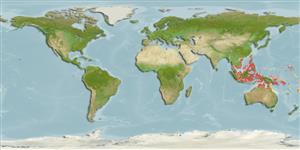>
Ovalentaria/misc (Various families in series Ovalentaria) >
Pseudochromidae (Dottybacks) > Pseudochrominae
Etymology: Pseudochromis: Greek, pseudes = false + Greek, chromis = a fish, perhaps a perch (Ref. 45335).
Eponymy: John Percy Moore (1869–1965) was an American zoologist who specialised in leeches. [...] (Ref. 128868), visit book page.
More on author: Fowler.
Environment: milieu / climate zone / Tiefenbereich / distribution range
Ökologie
seewasser riff-verbunden; tiefenbereich 12 - 25 m (Ref. 90102). Tropical
Western Central Pacific.
Size / Gewicht / Alter
Geschlechtsreife: Lm ? range ? - ? cm
Max length : 12.0 cm SL Männchen/unbestimmt; (Ref. 48635)
Rückenflossenstacheln (insgesamt) : 3; Rückenflossenweichstrahlen (insgesamt) : 25 - 26; Afterflossenstacheln: 3; Afterflossenweichstrahlen: 13 - 14. The Bali and Lombok population was recently described as a separate species as P. steenei on the bases of color differences. The white bar behind the eye, used to distinguish the species, fades in the Philippine and northern Australian populations, while in Sulawesi, it shows clearly. The ones with the orange head are thought to be male.
Body shape (shape guide): elongated; Cross section: compressed.
A very aggressive species that readily attacks the camera when it sees its own reflection. Mainly found on deep coastal slopes with remote sponges and crinoids in about 30 m depth and often occurs in pairs (Ref. 48635).
Life cycle and mating behavior
Geschlechtsreife | Fortpflanzung | Ablaichen | Eier | Fecundity | Larven
Gill, A.C., 1999. Pseudochromidae. Dottybacks (eelblennies). p. 2557-2577. In Carpenter, K. E. and V. E. Niem. 1999. Species identification guide for fisheries purposes. The living marine resources of the western central Pacific. Bony fishes part 2 (Mugilidae to Carangidae). FAO, Rome. : iii-v; 2069-2790. (Ref. 37748)
IUCN Rote Liste Status (Ref. 130435: Version 2025-1)
Bedrohung für Menschen
Harmless
Nutzung durch Menschen
Tools
Zusatzinformationen
Download XML
Internet Quellen
Estimates based on models
Preferred temperature (Ref.
123201): 27.5 - 29.4, mean 28.8 °C (based on 1019 cells).
Phylogenetic diversity index (Ref.
82804): PD
50 = 0.5000 [Uniqueness, from 0.5 = low to 2.0 = high].
Bayesian length-weight: a=0.00501 (0.00193 - 0.01299), b=3.10 (2.88 - 3.32), in cm total length, based on LWR estimates for this (Sub)family-body shape (Ref.
93245).
Trophic level (Ref.
69278): 3.7 ±0.5 se; based on size and trophs of closest relatives
Widerstandsfähigkeit (Ref.
120179): hoch, Verdopplung der Population dauert weniger als 15 Monate. (Preliminary K or Fecundity.).
Fishing Vulnerability (Ref.
59153): Low vulnerability (10 of 100).
🛈
